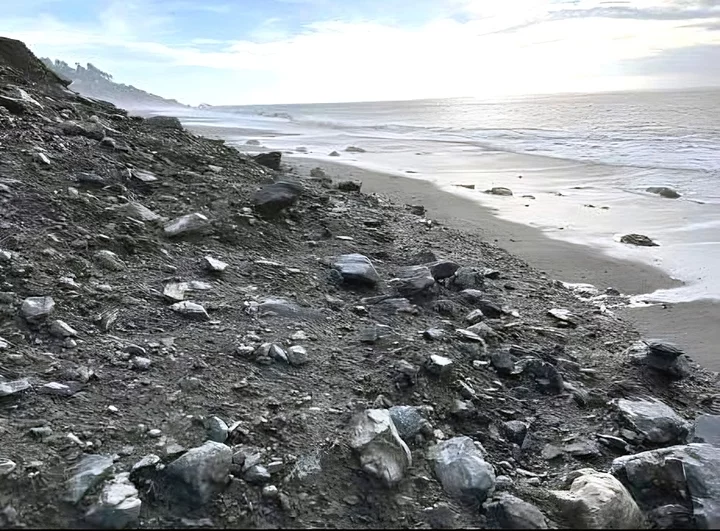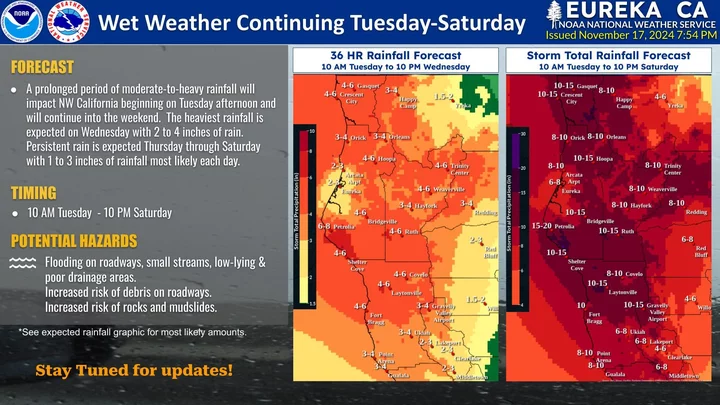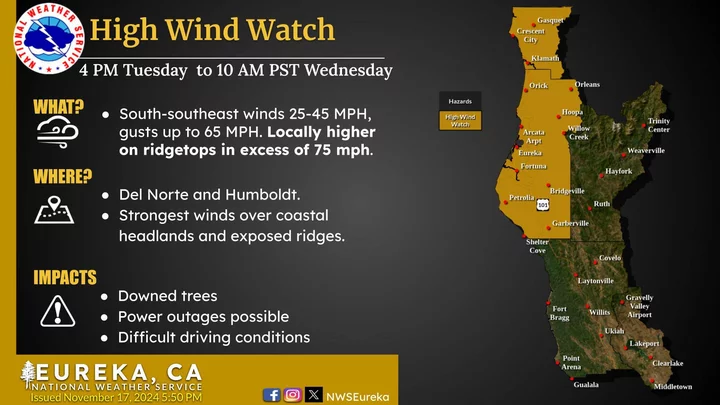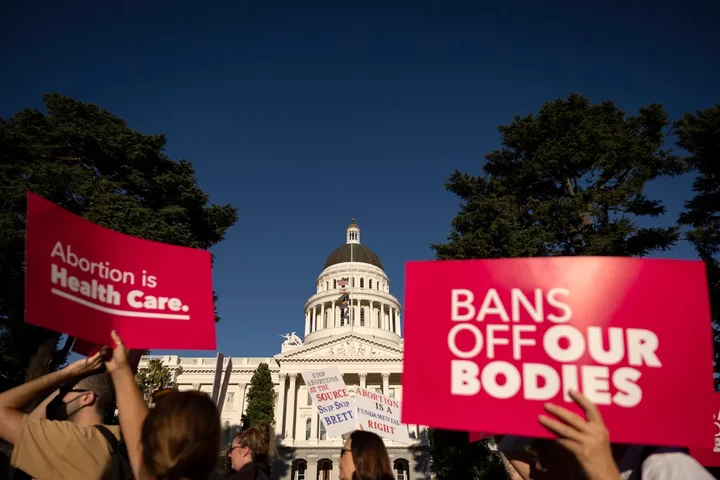Think Twice Before Hiking the Lost Coast! Landslides Near Shelter Cove Have Made Some Stretches Well-Nigh Impassable, BLM Says
LoCO Staff / Monday, Nov. 18, 2024 @ 10:52 a.m. / Emergencies
Photo: BLM.
Press release from the Bureau of Land Management:
The Bureau of Land Management is advising Lost Coast Trail hikers in the King Range National Conservation Area to be vigilant near three active landslide areas north of the Black Sands Beach Trailhead in Shelter Cove, and to consider postponing their hike.
Mud, rock and woody debris have been falling onto the trail in areas between Sea Lion Gulch and Randall Creek, and between Shipman Creek and Gitchell Creek. The slides are most active during and after rainstorms, and beach stretches can be impassable. The largest of these slides spans the entire beach about a half-mile north of the Black Sands Beach trailhead in an area popular for day hikes.
“In some areas the slides can block narrow stretches of beach,” said BLM Arcata Field Manager Collin Ewing. “Hikers should consider whether to proceed with their trip. If proceeding, they should assess conditions in slide areas and avoid the temptation to cross the landslides.”
Ewing stressed the importance of contacting the King Range Visitor Center, 707-986-5400, for information on trail conditions, tides, and creek levels before heading out.
The Lost Coast Trail is one of the few coastal hiking trails in the nation. There are no fees or permits required for day hiking, but overnight trips require permits available through www.recreation.gov.
The King Range also offers 80 miles of upland trails. Most are strenuous hikes due to the rugged nature of the King Range. Descriptions and conditions are available in the roads and trails report.
BOOKED
Today: 3 felonies, 12 misdemeanors, 0 infractions
JUDGED
Humboldt County Superior Court Calendar: Today
CHP REPORTS
No current incidents
ELSEWHERE
RHBB: Reports of Multi-Vehicle Collision at 5th and V Cause Traffic Delays in Eureka
RHBB: Yurt Fire Reported East of Willow Creek on Thanksgiving Morning
KINS’s Talk Shop: Talkshop November 27th, 2025 – Jason Esselman
Governor’s Office: Governor Newsom proclaims Thanksgiving Day
Prepare for Power Outages and Road Slides! A Big Atmospheric River Will Spill Over Humboldt This Week, National Weather Service Predicts
Hank Sims / Monday, Nov. 18, 2024 @ 7:40 a.m. / How ‘Bout That Weather
Graphics: National Weather Service.
Take note: Over the weekend, our “Weather Alerts” page — populated by the good people at the local National Weather Service office on Woodley Island — started to take note of a potentially wicked system coming our way this week. A lot of rain, wind and flooding looks to be our lot this week.
“Widespread power outages are expected,” the NWS says in its High Wind Warning, which warns of gusts of up to 60 miles per hour along the coast starting tomorrow night.
That’s the tip of the spear. All told, the storm is expected to continue until Saturday, and it’s going to bring a lot of rain.
“Steady moderate rain is expected during this period, with most areas seeing 2 to 4 inches of rain every 24 hrs during this period, with higher amounts expected in the mountains on SW facing slopes,” say the forecasters in their Flood Watch, which also warns travelers to brace for the usual landslides to block roads and highways.
The current version of the NWS’s Hydrologic Outlook paints the most complete picture of the storm to come. The office thinks that the worst rain will hit Wednesday, with steady downfall following for days after. It notes that the soils in Humboldt and Del Norte are already pretty much saturated, which means that the land is going to largely reject the water and send it straight downhill. That means localized flooding in flood-prone places, along with the havoc it the storm could play with our transportation system. The Eel River currently stands a 20 percent risk of busting its banks Thursday night, forecasters think.
So maybe it’s time to charge your batteries, reconsider your travel plans and such. It might be quite a week.
Human Bone Discovered in Redway Earlier This Year Belonged to Missing Person, Sheriff’s Office Says
LoCO Staff / Monday, Nov. 18, 2024 @ 7:02 a.m. / Crime
Press release from the Humboldt County Sheriff’s Office:
Earlier this year in July, Humboldt County Sheriff’s Office (HCSO) was dispatched to the Redway area for the report of a bone discovery. An immediate additional search of the surrounding area utilizing specialized K-9s did not yield any further findings.
The discovered bone was sent to the Department of Justice (DOJ) to be identified. On Nov. 14, the DOJ notified HCSO that it is confirmed to be the left tibia of Mark Burleigh, age 39, who has been missing since 2017. Search efforts will continue as part of the missing person investigation.
This case is still under investigation.
Anyone with information about this case or related criminal activity is encouraged to call the Humboldt County Sheriff’s Office at (707) 445-7251 or the Sheriff’s Office Crime Tip line at (707) 268-2539.
How Will Trump Change Health Care? California Braces for Fights Over Insurance and Abortion
Kristen Hwang / Monday, Nov. 18, 2024 @ 7 a.m. / Sacramento
Pro-abortion rights supporters marched in protest of a Supreme Court ruling that overturned Roe vs. Wade, in Sacramento on June 25, 2022. California abortion protections and other health care policies could be contested in a new Trump administration. Photo by Miguel Gutierrez Jr., CalMatters
The last time Donald Trump was president, his health care policies chipped away at the Affordable Care Act and helped eliminate federal abortion rights, leaving states to fill the gaps. In his second term, experts predict Trump’s agenda to be similar and warn that health care will get more expensive and harder to access for millions of people.
Congressional Republicans, newly empowered by Trump’s victory and the Senate moving to GOP control, have made it clear that they intend to try to implement long-standing conservative goals that include decreasing government spending on health care and further dismantling abortion rights, which are currently protected in about half of the country, including California.
Newly nominated Health Secretary Robert F. Kennedy Jr. has also pushed erroneous claims about vaccine hazards and exaggerated the risks of water fluoridation that could have ripple effects across state public health efforts.
The Democratic supermajority in the California Capitol, however, has spent the past several years passing laws to stymie future conservative administrations on health care, said Mia Bonta, chairperson of the Assembly health committee and a Democrat from Oakland.
Legislators have protected insurance coverage of abortion and transgender care. They have expanded health insurance programs to low-income undocumented immigrants and paid for it with state funds. They have taken pieces of the Affordable Care Act and written it into state law, expanding the enrollment period and banning lifetime limits on coverage. And they’ve invested millions of dollars into public health after the system languished for a decade.
“We were able to be very deliberate in the past several years to Trump-proof our health system moving forward,” Bonta said.
Not all state lawmakers have been happy with California’s health care expansions. Senate Republican Minority Leader Brian Jones, for instance, said public insurance for undocumented immigrants, which as of this year is available to all income-eligible immigrants, is too expensive and should be “delayed or repealed entirely.”
But Democratic lawmakers and health care advocates say they are better prepared than the first time Trump took office — though they expect the new administration to put California’s new laws to the test.
“We have their playbook from 2017, and almost everything they tried to do, California helped stop through our advocacy … or through court cases,” said Rachel Linn Gish, communications director for Health Access California. “In that way we are in a much stronger position than before.”
Affordable health care at risk
During his first term, Trump tried and failed to repeal the Affordable Care Act. He has said for his second term that he has “concepts of a plan” for the program that insures more than 21 million Americans.
Republican lawmakers in general have shifted away from talking about eliminating the program entirely, but some leaders, including Vice President-elect J.D. Vance have suggested changes that would make insurance more expensive. Vance during the campaign said he wanted to increase choices for consumers and “make the health insurance marketplace function a little bit better.”
Eliminating the health insurance marketplace, which is also known as Obamacare, has grown deeply politically unpopular even among Republican constituents. Since Trump’s first term, the number of people enrolled has grown by more than 9 million nationally. That political leverage is something that California advocates believe will help protect the program.
“More people are enrolled in (Affordable Care Act) marketplaces than ever before,” Linn Gish said.
But in many ways the state’s Achilles heel is federal funding. Federal spending on California health care programs is more than three times greater than the state’s share. That’s more than $117 billion from the federal government to support Medi-Cal and the Affordable Care Act compared to $35 billion from California’s general fund for all state health spending, which includes public health, state hospitals and social services.
And much of California’s policies can only be fully realized with sufficient money in the bank.
With the state grappling with a third consecutive deficit next year, the most immediate and likely federal health care cut will be difficult to prevent: financial assistance for middle-class families.
Outgoing President Joe Biden approved two rounds of Affordable Care Act subsidies during his presidency, making assistance available to middle-class families for the first time. Those subsidies will expire at the end of 2025, and Trump and congressional Republicans have signaled that they don’t want to renew them.
Without them, premiums will increase by an average of $1,000 annually for residents with insurance through Covered California, the state’s Affordable Care Act program. Premiums are already set to increase by about 8% next year, and without federal assistance other out-of-pocket costs such as deductibles and copays will most likely spike as well.
Prior to Biden’s push to lower health care premiums, many Californians paid upwards of 18% of their income on health insurance, according to Covered California data. Federal assistance capped that expense at 8.5%.
“You’re talking about a world where we’re doubling how much people pay,” Linn Gish said.
In 2023, California lawmakers established a backstop of state funding to help more people afford health insurance, but those reserves can’t make up the gap if federal funding stops.
Health care for immigrants
Medi-Cal, the state Medicaid program, offers expansive benefits to all low-income individuals regardless of immigration status. The program could face uncomfortable cuts with a less-than-friendly federal administration.
Federal dollars cover about 70% of Medi-Cal’s program costs, while the state invests approximately $30 billion in general fund spending.
“The largest concern many of us have who have worked with our state budget is the resources we will be receiving from the federal government this upcoming year,” said Assemblymember Joaquin Arambula, a Democrat from Fresno who has focused on expansions for undocumented workers. “There are many who are struggling who need their government to help.”
About 7 million more Californians qualified for Medi-Cal after Affordable Care Act rules allowed the state to bump up income limits in 2014, and about 1.8 million undocumented immigrants have gotten Medi-Cal coverage after the state began expanding eligibility for them in 2015.
Some California Republicans have strayed from the party platform when it comes to health care for undocumented immigrants. The Central Valley relies heavily on immigrant labor, and a handful of state Republicans from those communities supported expanded access to health insurance for undocumented residents.
The state GOP, however, still officially opposes coverage for undocumented immigrants and several Republican lawmakers want the state to undo that health care expansion.
Gov. Gavin “Newsom and Democrat lawmakers insist on expanding free health care for illegal immigrants to the tune of $5 billion per year. In the midst of a multi-billion dollar budget deficit, hospitals and maternity wards shutting down, and a massive influx of migrants illegally crossing our open border, we should not be expanding this costly government program,” Jones, a Republican from San Diego said.
Immigrants who came to the United States in their youth and who are protected by the Obama-era program known as Deferred Action for Childhood Arrivals (DACA) for the first time can enroll in Covered California thanks to expanded eligibility under the Biden administration.
Liberal lawmakers and policy advocates hailed the expansions as a long-sought-after victory, but they remain controversial among California Republicans. Many lawmakers and advocates expect these expansions to be challenged over the next four years.
“Anything that has Biden’s fingerprints on it is going to be the first touched. The DACA expansion is going to be high on the list,” Linn Gish said.
This year a bill expanding Covered California to all undocumented immigrants, not just those who came to the U.S. as children, stalled in committee. That measure would have allowed immigrants who make too much money to qualify for Medi-Cal to purchase insurance.
Arambula, who authored the bill, said those populations are “unjustly excluded” from buying insurance at full price even if they want to. He plans on reintroducing the measure, which could be implemented without federal approval.
Family planning and abortion cuts
On the campaign trail Trump took credit for appointing the Supreme Court justices who ended the national right to abortion by overturning Roe vs. Wade, but he said he would not support a national law banning abortion.
Still, California Democrats aren’t taking any chances on abortion rights. They passed more than two dozen laws to protect access to abortion, contraceptives and gender-affirming services in the last three years.
In 2022, voters also protected abortion as a right in the state constitution.
Democratic lawmakers say they have more work to do.
Bonta said she plans on introducing bills to further protect reproductive rights on the first day of the legislative session. Those bills would require hospitals to provide emergency abortions, protect birth control for Medi-Cal recipients and ease the regulation of birth centers. Bonta said lawmakers are working quickly and she expects many of the bills introduced in December to have urgency clauses that allow immediate implementation.
“It’s going to be a huge change within the health care space,” she said.
The first time Trump was president, he also dismantled Title X regulations that fund the federal family planning network by instituting a “gag rule” prohibiting clinics from performing or referring for abortions. The clinics funded have historically provided contraceptives, abortion care, sexually transmitted infection testing and treatment, gynecology services and postpartum care. After the rule change, the number of people served by Title X clinics dropped 60% nationally as a result of clinics exiting the program, according to the Kaiser Family Foundation, an independent health policy research center..
In California the number of people served dropped from 1 million to fewer than 200,000, said Amy Moy, co-CEO of Essential Access Health, which administers the state’s Title X money.
California dedicated $10 million to bridge the gap, but Moy said if there is another federal cut, clinics say to expect longer wait times and fewer providers.
“We will be having to test the bounds of our guardrails and see what we can do here, but we are committed to working with partners and state leaders to do everything possible,” Moy said.
###
Supported by the California Health Care Foundation (CHCF), which works to ensure that people have access to the care they need, when they need it, at a price they can afford. Visit www.chcf.org to learn more.
CalMatters.org is a nonprofit, nonpartisan media venture explaining California policies and politics.
OBITUARY: Antonia Dobrec, 1942-2024
LoCO Staff / Monday, Nov. 18, 2024 @ 6:56 a.m. / Obits
On November 5th, at the dimming of the day, Antonia Dobrec took her
last earthly breath and joined the ancestors. She was a descendant
of the Tolowa, Yurok, and Chetco peoples. She was born in Arcata.
She was the last child of four, affectionately known as Babe. She
was reared in Trinidad near open fields and redwood trees.
She went to Trinidad Elementary, Arcata High School, Del Norte High School, HSU, the University of Kansas, and the University of Oklahoma. In high school she excelled in sports and band, and while at Arcata High School she received the Circle A. In 1976 she received her MSW from the University of Kansas.
She had over 30 years of experience in providing training and technical assistance for Indian tribes and organizations. This experience was grounded in the planning, development, implementation, and evaluation of family based services. Her background in family services included: Head Start, adoption, foster care, and child protective services.
From 1980 to 1997 she was president and director of projects at Three Feathers Associates in Norman, Oklahoma. Her responsibilities during that time were vast and too numerous to list here, but know that it involved great dedication to indigenous peoples all over the USA.
She is survived by her nieces and nephews, Victor Dobrec, June Sullivan, Michael Dobrec, Sally Jones, Denise McKenzie, Leslie Patrick, Bill McKenzie, Mary Dawn Ford, Lee Dobrec, and Alexander, Robert, Francine, and Michael De La O, and their families.
Toni was preceded in death by her parents, Victor Anton Dobrec and Mary Mattz Dobrec Gray, her sisters Joann McKenzie and Carmen De La O, niece Kelly McKenzie, and nephew David De La O. We are very grateful to all those who provided care for Toni, including Hospice of Humboldt, the staff at St. Joseph Hospital, and the generous friends and “Angels” who were so caring and supportive. Donations in her name can be made to NIHSDA, P.O. Box 5508, Norman, Oklahoma, 73070, or a charity of your choosing.
###
The obituary above was submitted on behalf of Antonia Dobric’s loved ones. The Lost Coast Outpost runs obituaries of Humboldt County residents at no charge. See guidelines here. Email news@lostcoastoutpost.com.
OBITUARY: Wilma Pauline Evans, 1943-2024
LoCO Staff / Monday, Nov. 18, 2024 @ 6:56 a.m. / Obits
Wilma
Pauline Evans
March
3, 1943-October 14, 2024
Wilma Pauline Evans, better known as Pauline or Grandma to most, passed away peacefully at home in her daughter Tammy’s arms, with her son Billy Jr, her niece Penny and some grandkids, on October 14 2024.
Pauline was born in Dustin, Oklahoma on March 3, 1943 to Jesse and Lola Morton. They then moved to Selma, Calif. where she would grow up until her sophomore year in high school. They would then relocate to Hydesville. She would then attend and graduate from Fortuna High.
After graduation she then met and married Billy Evans Sr. They would marry in 1961 and bought their house in Alton in 1966. They had two children, Billy Jr and Tammy. Pauline spent most of the kids’ younger years being a stay-at-home mom, which she loved!
When the kids were in high school she found a job as a secretary at Fortuna Wheel and Brake. There she became involved in many activities and hobbies, such as cars and sports. She would later leave Fortuna and move to Anderson, Calif., where she worked at Silver Thorne Resort. After living there for a few years she decided to move back to Fortuna and found a job working for the City of Rio Dell until she retired. Pauline didn’t like sitting around, so she got a part-time job working at Sherlock mini-storage and Robbins Nest daycare.
Pauline’s love for cars and sports would surely grow over all these years. She would go watch NASCAR over a 10 year span with her good friend Jim Daetwiler. Her all-time favorite was Rusty Wallace. She was very involved in the Ladies Auxiliary and Fortuna AutoXpo, where she left running the show and shine to her grandkids. So many AutoXpo family and friends that will miss her dearly, it will just not be the same without her!
Pauline enjoyed movies as well. She and her best friend, Colleen, were always going to new movies that would come out, and we all loved hearing about them. She also had a huge involvement in making sure family reunions ran smoothly with her sisters. Also that we all ate good food and sweets. Pauline loved to cook, bake and can. One of her most famous was her peanut butter pie, which was a birthday or holiday treat for all of us! Her love for cooking and baking have trickled down the family tree too — her kids and grandkids, we are all greatful we have a cookbook to go by!
On a Sunday you could catch her at home watching a Vikings football game or a recorded game of the Giants or Golden State Warriors and more than likely she would be talking to her sister Brenda about the game, score and stats while they both watched any game!
Pauline was huge in our community and will be greatly missed by not just friends and family but clubs and activities.
We are so grateful that you were our grandma. You have filled our lives with so much love and precious memories you will always be loved and forever missed!
Pauline is proceeded in death by:
Parent: Jesse and Lola Morton
Ex-husband: Billy Evans Sr.
Siblings: Sonny Morton, Garnett Buckner and Brenda Delmenico
Nephews: Noel Morton & Dewayne Buckner
Grandson: Dakota Evans
Great-granddaughter: Jessilyn Evans
Pauline was survived by:
Children: Billy Evans Jr. (April), Tammy Evans and Sharon Hicks
Sisters: Bobbie Buckner, and Sue and Bill Gordon
Sister-in-law: Evelyn Flothe
Grandkids: Billy Evans III (Melita), Joshua Evans (Terri), Austin Evans (Ashleyanna) Jessica Evans, Jasmine Menroe-Page (Doug), Hannah Pollard (Michael), Tavin Evans, Jimmy Daetwiler, Garyn Evans, Jessica Gonzalez, Brandon Harper and Anthony Ramirez
Bonus Grandkids: Cody Burns, Haley Green (Alex), Jenny Metcalfe, Bruin Gormley Robbins, Persephone Robbins, Breezie Donahue
20 Great-grandkids
Special Nephew: Frankie Collings
Special Nieces:Penny & Dawn
Best Friend: Colleen Mcguire
Many more family, friends, nieces, nephews, brother/sister in-laws & cousins that will really miss her!
The Evans family asks you to join them for coffee, tea and sweets at the Fortuna Fire Hall Saturday November 23 at 1 p.m.
###
The obituary above was submitted on behalf of Pauline Evans’ loved ones. The Lost Coast Outpost runs obituaries of Humboldt County residents at no charge. See guidelines here. Email news@lostcoastoutpost.com.
(VIDEO) ‘The California Nobody Knows’: Popular YouTuber Wanders Around Humboldt County With Local Farmer, Songwriter Brett McFarland
Isabella Vanderheiden / Saturday, Nov. 16, 2024 @ 1:33 p.m. / :) , Feel Good , Our Culture
###
Humboldt’s going viral again!
Sometime in the last month or so, popular YouTube travel vlogger Peter Santenello visited Humboldt County to learn about the vibrant community and towering trees local farmer and songwriter Brett McFarland sings about in his song “Humboldt,” a love letter to this beautiful place we call home. Santenello’s video has amassed more than 125,000 views since it was posted this morning.
In the video, Santenello heads out to Crazy River Ranch to chat with a barefoot McFarland about the challenges of running an organic farm, his stint in prison, the back-to-the-land movement and much, much more.
“Humboldt County … is sort of a cultural melting pot where you have people that have very different values living close to each other and working together,” McFarland tells Santenello. “That’s one of the things I think is really beautiful [about this place]. … We have people that think differently … but I feel like people are a lot more tolerant of one another.”
After spending some time at the farm with local artist Ken Jarvela, McFarland and Santenello bop on over to the Arcata Farmer’s Market to share fresh-pressed apple juice with local vendors. They also swing by the Front Porch Inn, the boutique hotel McFarland runs with his wife, Julia. Then they head over to Blue Ox Millworks to chat with Eric Hollenbeck, nationally acclaimed woodworker and star of the Magnolia Network series The Craftsman. From there, McFarland and Santenello head north to check out Humboldt’s iconic trees at Redwood National Park.
“There’s just no way to capture it on camera,” Santenello says as he points his camera skyward trying to capture the towering trees. “This is so rad.”
While they’re wandering around the forest they run into a couple visiting from Germany and Brett invites them to his birthday party later that evening. What a guy!
Do yourself a favor and click “play” on the video above.







